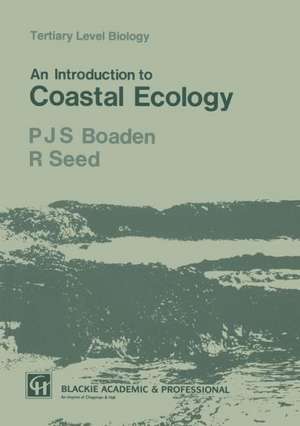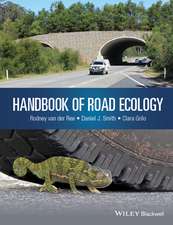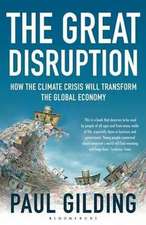An Introduction to Coastal Ecology: Tertiary Level Biology
Autor P.J. Boaden, R. Seeden Limba Engleză Paperback – 31 dec 1988
Din seria Tertiary Level Biology
- 15%
 Preț: 637.59 lei
Preț: 637.59 lei -
 Preț: 381.00 lei
Preț: 381.00 lei -
 Preț: 382.95 lei
Preț: 382.95 lei -
 Preț: 379.86 lei
Preț: 379.86 lei -
 Preț: 381.59 lei
Preț: 381.59 lei -
 Preț: 387.20 lei
Preț: 387.20 lei -
 Preț: 362.82 lei
Preț: 362.82 lei -
 Preț: 386.99 lei
Preț: 386.99 lei -
 Preț: 382.18 lei
Preț: 382.18 lei - 15%
 Preț: 633.02 lei
Preț: 633.02 lei -
 Preț: 386.00 lei
Preț: 386.00 lei -
 Preț: 379.09 lei
Preț: 379.09 lei -
 Preț: 385.47 lei
Preț: 385.47 lei -
 Preț: 387.20 lei
Preț: 387.20 lei - 18%
 Preț: 721.01 lei
Preț: 721.01 lei -
 Preț: 387.38 lei
Preț: 387.38 lei -
 Preț: 384.48 lei
Preț: 384.48 lei -
 Preț: 382.95 lei
Preț: 382.95 lei -
 Preț: 351.90 lei
Preț: 351.90 lei -
 Preț: 381.59 lei
Preț: 381.59 lei -
 Preț: 382.36 lei
Preț: 382.36 lei -
 Preț: 380.07 lei
Preț: 380.07 lei - 15%
 Preț: 636.45 lei
Preț: 636.45 lei -
 Preț: 381.59 lei
Preț: 381.59 lei - 15%
 Preț: 660.18 lei
Preț: 660.18 lei -
 Preț: 390.84 lei
Preț: 390.84 lei -
 Preț: 384.31 lei
Preț: 384.31 lei -
 Preț: 385.62 lei
Preț: 385.62 lei -
 Preț: 384.86 lei
Preț: 384.86 lei -
 Preț: 385.08 lei
Preț: 385.08 lei -
 Preț: 378.92 lei
Preț: 378.92 lei -
 Preț: 379.48 lei
Preț: 379.48 lei -
 Preț: 384.70 lei
Preț: 384.70 lei -
 Preț: 404.67 lei
Preț: 404.67 lei -
 Preț: 381.00 lei
Preț: 381.00 lei -
 Preț: 394.71 lei
Preț: 394.71 lei -
 Preț: 376.96 lei
Preț: 376.96 lei -
 Preț: 379.09 lei
Preț: 379.09 lei -
 Preț: 382.18 lei
Preț: 382.18 lei - 15%
 Preț: 637.59 lei
Preț: 637.59 lei -
 Preț: 385.47 lei
Preț: 385.47 lei -
 Preț: 380.07 lei
Preț: 380.07 lei -
 Preț: 387.38 lei
Preț: 387.38 lei -
 Preț: 380.25 lei
Preț: 380.25 lei -
 Preț: 418.76 lei
Preț: 418.76 lei
Preț: 382.18 lei
Nou
Puncte Express: 573
Preț estimativ în valută:
73.15€ • 76.08$ • 61.30£
73.15€ • 76.08$ • 61.30£
Carte tipărită la comandă
Livrare economică 14-28 martie
Preluare comenzi: 021 569.72.76
Specificații
ISBN-13: 9780751401097
ISBN-10: 0751401099
Pagini: 218
Ilustrații: VI, 218 p.
Dimensiuni: 148 x 210 x 12 mm
Greutate: 0.28 kg
Ediția:1985
Editura: SPRINGER NETHERLANDS
Colecția Springer
Seria Tertiary Level Biology
Locul publicării:Dordrecht, Netherlands
ISBN-10: 0751401099
Pagini: 218
Ilustrații: VI, 218 p.
Dimensiuni: 148 x 210 x 12 mm
Greutate: 0.28 kg
Ediția:1985
Editura: SPRINGER NETHERLANDS
Colecția Springer
Seria Tertiary Level Biology
Locul publicării:Dordrecht, Netherlands
Public țintă
ResearchCuprins
1 The Coastal Environment.- Coastal topography-embayed coasts, plains coasts, new coasts. Cliffs. Sediments. Water movement-waves, internal waves, storm surges, tsunamis, tides, seiches, currents. Temperature, salinity and thermoclines. Organic matter. Maritime climates.- 2 The Neritic Province.- Plankton-phytoplankton, zooplankton, meroplankton, bacterioplankton. Adaptations amongst planktonic organisms. Light, nutrients and the seasonal cycle. Grazing. Spatial patterns-patchiness, vertical migration. Trophic interrelationships. Productivity.- 3 Life on Rocky Coasts.- Life habits and adaptations-water movement, desiccation, temperature and light, feeding strategies, life cycles. Zonation-a descriptive framework. Factors influencing zonation-physical factors, biological factors, settlement and behaviour. Geographical and local distribution, patchiness. Disturbance, diversity and community organization. Productivity and trophic interrelationships. Other habitats-algal epifaunas, crevices, tidal rapids, boulders, subtidal rock.- 4 Life in Sediments.- The physical background. Prokaryotes and interstitial chemistry-sediment sulphur cycling. Sediment Protista. Macrophytes-sea-grasses, sea-grass communities. Bottom communities. Some macrofaunal representatives-Polychaeta, Mollusca, Crustacea, Echinodermata. Bioturbation. Meiofauna-sand meiofauna, meiofaunal and benthic productivity. Other aspects.- 5 Brackish-Water Environments.- Types of estuary-coastal plain estuaries, bar-built estuaries, tectonic estuaries, fjords. Major environmental features-water circulation and salinity, sedimentation, other factors. The biota of estuaries. Adaptations of estuarine organisms. Productivity and food webs. Brackish and hypersaline environments-estuarine realms, hypersaline lagoons, brackish seas, tidepools, brine seeps.- 6 Coral Reefs.- Classification-fringing reefs, barrier reefs, atolls, patch reefs. Distribution and limiting factors. Reef morphology and zonation. Nutrition, calcification and growth. Species interactions-mutualism, competition, predation, grazing. Physical disturbance. Diversity gradients and biogeography. Productivity.- 7 Marshes and Mangroves.- Saltmarshes: Establishment. Succession, zonation and marsh structure. Other flora and fauna. Trophic structure and energy flow. Mangroves: Geographical distribution. Zonation. Succession. Adaptation of mangroves. Mangrove fauna. Primary productivity; trophic interrelationships.- 8 Other Coastal Habitats.- Sand dunes-the strandline, dune ridge formation, dune slacks, dune fauna. West coast deserts. Shingle beaches. Grassland and heath. Coastal woodlands. Cliffs. Swamps and mires. The ice edge.- 9 The Inshore Harvest.- Sponges. Corals. Worms. Crustacea-shrimps, crabs, lobsters and spiny lobsters. Mollusca-bivalves, gastropods, squid and octopus. Commercial fish-demersal fish, pelagic grazers, pelagic predators, fisheries research, fish culture. Other coastal fish. Higher marine vertebrates-snakes and lizards, crocodiles and turtles, marine mammals. Seaweed resources. Environmental impact of fisheries.- 10 Coastal Birds.- Classification of coastal birds. Distribution. Adaptations to the marine environment. Food acquisition. Breeding ecology. Mortality, longevity and regulation of numbers. Migration and foraging. The importance of birds in coastal ecosystems.- 11 Coastal Management.- Physical resources-space, power generation. Mineral resources. Pollution-pesticides and related compounds, heavy metals, radioactivity, oil, organic matter, nutrients. Public health. Pests and introductions. Fouling. Access, recreation and tourism. Planning and legislation. Coastal conservation-detection and prediction of change, coastal nature reserves. System modelling. In conclusion. Envoi.- References and Further Reading.
Recenzii
This is an excellent book in its field. Undergraduates or even laymen will find it easy to read yet informative and up-to-date. Journal of Ecology













